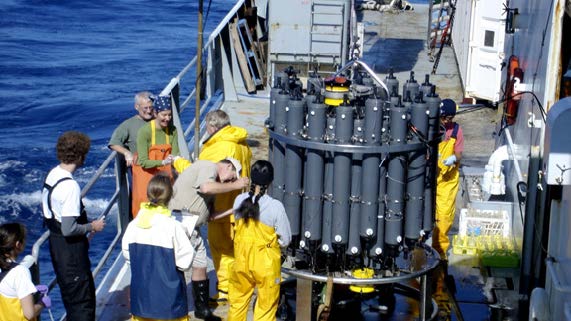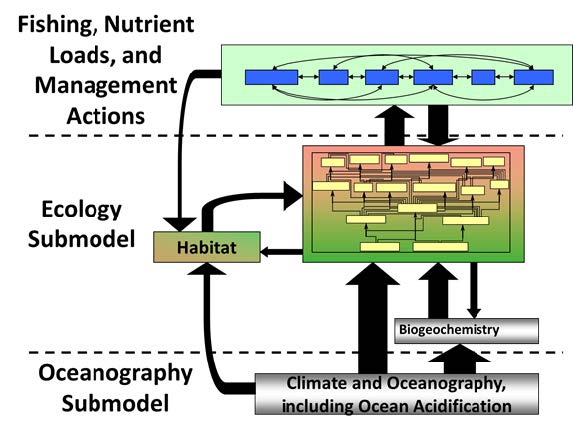Ocean Acidification on the Pacific Coast

Courtesy NOAA/Pacific Marine Environmental Laboratory
Of every 100 tons of carbon dioxide put into the air from burning fossil fuel to power our cars and factories, about 30 tons are absorbed by the ocean. The chemical changes from all that carbon dioxide are acidifying the ocean at a rate faster than has occurred at least over the past 50 million years of Earth’s history and perhaps much longer. Scientists are trying to understand what these rapid changes mean for ecosystems on our Pacific Coast. That research involves an integrated monitoring system to track ocean carbon dioxide and pH changes, lab experiments to test how particular species respond to increased acidity and computer modeling to predict how effects on vulnerable species will ripple though the food web because of interactions between predators and prey.
These studies show that we are headed for some real changes in Pacific Coast ecosystems. Because of ocean circulation patterns, waters on our shores are naturally higher in acidity than other parts of the ocean, and increased carbon dioxide from people makes the situation worse. Many species, particularly those that make shells, are harmed by increased carbon dioxide, though a few species, like some plants, grow better. The picture of how all this will affect entire ecosystems is less certain, but a coordinated project between the NOAA Northwest Fisheries Science Center and the NOAA Pacific Marine Environmental Laboratory is attempting to piece it all together.
This modeling project combines data on atmospheric carbon dioxide inputs, ocean circulation patterns, marine chemistry, nutrient availability, climate information, and food web relationships to understand the consequences of ocean acidification. The model even includes information on Pacific Coast fishing fleets to explore how changes in fishing policy might interact with increased acidification. A key part of this project is to understand how local species may be directly affected by ocean acidification. Review of experiments relevant to species in our region shows particular vulnerability for shellfish, with many species showing poor larval survival in acidified waters because of problems in the formation of shells early in development.
Projects like this will increase our understanding of how ocean acidification is changing our ocean ecosystems. An even more challenging task is finding and implementing actions to address the negative effects of acidification. The obvious response is to address the primary cause of acidification by reducing emissions of carbon dioxide. As decades of effort to tackle this problem have shown, this is far easier said than done. However, the potential impacts of ocean acidification compel a careful look at all options, from small steps by individuals to major efforts by industry and governments. In addition to reducing overall carbon dioxide emissions, research shows that reducing other stressors in the marine environment, like excessive nutrient run off, may help mitigate the effects of acidification. Many of the other stressors are more readily addressed at a local level. Both the National Parks Service and the NOAA Marine Sanctuaries are an excellent source of information on these efforts. In addition, a report from the Washington State Blue Ribbon Panel on Ocean Acidification is the first concerted effort the nation to tackle both the science of acidification and potential solutions at a state level. The recommendations of the panel gave rise to the Washington Center on Ocean Acidification at the University of Washington, which dedicated to exploring regional approaches to a global problem.

Courtesy I. Kaplan
Ocean Acidification Science and Communication Emerging and Evolving Together

Each day, scientists gain new scientific knowledge and understanding about the potential impacts of ocean acidification. Because this is a rapidly expanding field of research on a potentially large threat to humans and coastal and ocean ecosystems; educators, communicators, and scientists must work together to effectively explain ocean acidification (OA). A number of workshops and research studies have been held to identify effective ways to convey this information to a variety of different audiences and stakeholders. Through these workshops and ongoing dedicated OA working groups, the community has identified certain effective practices for communicating about OA.
A Unique Opportunity
Communicating about ocean acidification provides an opportunity to inspire action; as of 2010, only 7% of Americans report that they have heard much about this issue (Data from Six Americas, June 2010). A US public opinion poll revealed that after reading the definition of OA (without impacts or implications included), 75% of those polled think OA is a serious threat, with 32% saying it is among the most serious threats to ocean health (Edge Research, 2011). The perception of OA as a threat increases 150% when a definition of the changing ocean chemistry is provided. These findings highlight that 1) 9 in 10 people in America have yet to hear about OA and 2) when OA is briefly described to a member of the public, there is cause for concern and this opens the door to empowering those listening to take action.
Starting the Conversation
Success in having the OA conversation means having a few critical “communication points” in place even if they are brief. For example:
• Establish the role, importance and function for the ocean
Examples include:
- The ocean is a primary driver of weather and climate.
- The ocean is a source of clean fresh water – most of the rain that falls on land comes from the tropical ocean.
- The phytoplankton (microscopic plants) that live in the ocean are
responsible for almost half the oxygen we breathe.
• Distinguish ocean acidification from climate change.
• Use “emission from factories, energy plants, cars, etc.” when describing carbon dioxide; carbon dioxide described as tangible pollutant.
• Let the audience know they have a role to play both at the individual and community level.
• Focus on outcomes and solutions for which audiences can be helpful, foregoing the doom and gloom and instead offering solutions that are on the same scale as the problem.
Ocean acidification is a global issue and we are only beginning to understand its effect(s) at regional, local and species levels. Only through working closely together as a collective community of scientists, science communicators and educators will we be able to effectively raise awareness of our ocean’s changing chemistry and increase the public’s understanding of the impacts of this change.
Olympic Ocean Stewards--A New Junior Ranger Program

Courtesy W. Butterworth
Waves crash along rocky headlands with thunderous booms sending spray high into the air. Pelicans glide close to the ocean swells while bald eagles soar above sea stacks and offshore islands. Huge piles of enormous beach logs guard sandy beaches and testify to the power of winter storms even on the calmest of summer days. When the tide recedes, rocky pools provide perfect opportunities to explore colorful invertebrates that survive the extreme shifts from water to air and back again.
The remote Pacific Coast found in Olympic National Park and the Olympic Coast National Marine Sanctuary is a world removed from many visitors’ experience. Park staff, with input from sanctuary staff, designed a new Junior Ranger Program to help visitors over age four to learn, explore and protect this beautiful place and the diversity of life found here. Through a series of workbook activities the Ocean Steward program guides prospective junior rangers’ exploration of the ocean and coastal ecosystems. Activities were designed to support Ocean Essential Principles and Fundamental Concepts of an ocean literate public and to highlight the long term intertidal and marine debris monitoring conducted by park and sanctuary scientists. Other activities highlight Leave No Trace principles important to safely enjoy and minimize impact to the designated Wilderness stretches of coast. All activities encourage personal connections with ocean and coastal resources with the ultimate goal of creating the next generation of ocean stewards. Upon completion of the required activities in the book the new Ocean Stewards are awarded a patch and promise to protect the ocean and its life, to continue to explore and to share their discoveries with others.
Ocean Acidification Facts

Courtesy NOAA Pacific Marine Environmental Laboratory
• One third of all carbon dioxide emitted by humanity has been absorbed by the world’s oceans. This is making them more acidic than they have been for tens of millions of years.
• One of the greatest impacts that Ocean Acidification is having is on reef building corals, which are known as a ‘framework species’. Without corals, reefs cannot exist.
• As oceans have warmed, oceanic nutrient deserts have expanded by 6.6 million square km’s over the past two decades.
• There are approximately 10,000 Coral Reefs and we are destroying one every other day.
• Coral Reefs provide habitat for at least a quarter of all marine species. Many of these face extinction if reefs disappear.
• The Great Barrier Reef generates over $6.5 billion in tourism revenue and 63,000 jobs.
• Growing evidence suggests that four of the five Great Mass Extinctions have been associated with rapidly acidifying oceans –due to spikes in the concentration of atmospheric CO2.
• Coral Reefs are being lost more than twice as fast as the rainforests. Current estimates reveal that we will lose the other 50% over the next 40 years.
• The biological diversity and splendour of Coral Reefs are at risk of disappearing for thousands of years. This places in jeopardy an estimated 500 million people who depend on coral reefs for their daily food and income.
Contributors
Dean Butterworth, Olympic National Park
Paul McElhany, Ph.D., NOAA-Northwest Fisheries Science Center
Jenn Bennett Mintz, NOAA Ocean Acidification Program
Editor:
John Dell’Osso, Point Reyes National Seashore
Part of a series of articles titled Pacific Ocean Education Team (POET) Newsletters.
Previous: POET Newsletter February 2014
Last updated: October 8, 2021
